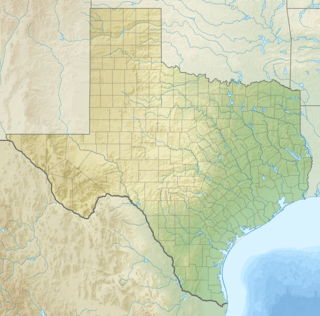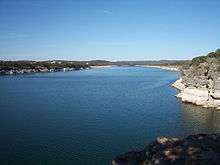Llano Uplift
| Llano Uplift | |
|---|---|
 location of Llano Uplift in Texas | |
| Geography | |
| District | Texas Hill Country, Llano County, Texas |
| Range coordinates | 30°10′27″N 99°03′55″W / 30.1742°N 99.0653°WCoordinates: 30°10′27″N 99°03′55″W / 30.1742°N 99.0653°W |
| Geology | |
| Orogeny | Grenville orogeny |
| Age of rock | Mesoproterozoic |
The Llano Uplift is a roughly circular geologic dome of Precambrian rock, primarily granite, in Central Texas in the United States. It is located in the eastern region of the Edwards Plateau and northern region of the Texas Hill Country. The region is characterized by a central exposure of Precambrian granite (Town Mountain granite), surrounded by a ring of gneiss and schist (Valley Spring gneiss and Packsaddle schist, respectively, also Precambrian), which is in turn surrounded by uplifted lower Paleozoic strata. This area is rimmed by limestone ridges.
The Llano Uplift is best known for its large, protruding rock formations, such as Enchanted Rock. The area includes several major quarries like Granite Mountain that mine the distinctive pink granite. Further, the area contains the only known deposits of llanite.
Geology
The area is termed an uplift due to the raised status of the Precambrian rocks in comparison to adjacent, completely buried Precambrian strata, as well as Paleozoic rocks that are buried elsewhere in central Texas.
However, the exposures of Precambrian rock are generally located at the lowest surface elevations of the region. This is best pictured by imagining the igneous roots of an ancient mountain range buried entirely beneath newer sedimentary strata, followed by the erosion of the newer strata to the extent that some of the "highest" igneous rocks are exposed.
The origin of the Town Mountain granite, but tightly-dated to late Mesoproterozoic times, is a minor mystery, stemming from a debate over whether or not it is related to the Grenville orogeny.[1][2] What is not in doubt in that the Valley Spring and Packsaddle formations are heavily metamorphosed sedimentary rocks, originally deposited south of the North American craton, and altered by subduction or continental collision.[3][4]
The ancient faulting that produced the Llano Uplift is believed to be related to that which produced the Marathon Uplift in West Texas. Both may have been formed around the time of the Ouachita orogeny.
Mineralogy
The Llano Uplift is ancient, with some parts being over a billion years old, and as such it has a wide variety of minerals and ores within the area. Several gold mines operated in this area, the most famous of which is the Heath mine. Some minerals that have come out of the mines include quartz, pyrite, and schorl.[5] Road cuts and creeks provide more samples of minerals found in this area, with Texas' renowned blue topaz and smoky quartz having been found.[6] Various iron and copper minerals have been found, especially hematite and malachite.
| Llano uplift context and features | ||||||
|---|---|---|---|---|---|---|
|
See also
Notes
- ↑ Reed, Robert M. and Helper, Mark A. (1994) Evidence for solid-state deformation of ~1.1 Ga "anorogenic" granites in the Llano Uplift, Texas. Geological Society of America Abstracts with Programs, 26, 1, 25
- ↑ Town Mountain Granites map
- ↑ Central Mineral Region field trip. September 19, 1998
- ↑ Reed, Robert M., et. al., SEDIMENTARY STRUCTURES, PALEO-WEATHERING, AND PROTOLITHS OF METAMORPHIC ROCKS, GRENVILLIAN LLANO UPLIFT, CENTRAL TEXAS
- ↑ Heath Gold mine data on Mindat.org
- ↑ http://geology.uprm.edu/Morelock/thcgeol.htm




